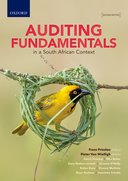Auditing Fundamentals in a South African Context 2e is a practical, applied and engaging introductory textbook that supports students throughout the undergraduate level of the Auditing curriculum. The text is designed to enhance learning by supporting holistic understanding: theory is presented within the framework of the real-world business environment, assisting students to apply principles and standards with an understanding of their context.
The text offers a clear pedagogical framework, which supports applied learning and develops independent, critical and reflective engagement with the subject matter. A continuing case study, which follows each stage of the audit of a South African company, demonstrates the practical application of learned
principles and the integration of the auditing process with a typical audit client's business.
The second edition is comprehensively revised to reflect all relevant, recent changes in the requirements of legislation, financial repor ti ng and auditing pronouncements and codes, and addresses the new Code of Professional Conduct which was issued by the SA Institute of Chartered Accountants in the final quarter of 2018.
Additional educational resources support teaching and learning, assisting students to develop the academic skills required to master their studies.
Features
- The text is thoroughly revised and updated to reflect recent regulatory developments and changes.
- The second edition addresses the recommendations of the King IV Report on Corporate Governance, and introduces new discussions relating to governance principles. In particular, the text discusses non-compliance with laws and regulations, and issues related to the rotation and independence of auditors.
- The text reflects the amended code of professional conduct introduced by the IRBA Committee for Auditor Ethics.
- The second edition offers additional examples of substantive procedures, and provides explanation of how financial reporting standards and provisions of the Companies Act are applied when formulating substantive procedures.
- The second edition includes a new appendix, which addresses basic systems and control theory, and the components and operation of computerised accounting information systems. This material will equip readers with a basic knowledge of these aspects in order to be able to (1) understand an IT system and the related controls in the role of an accountant or auditor and then to use this understanding to (2) assess risks arising from the IT system and related controls. The body of the text will include references to the appendix where appropriate.
- Supporting student success and effective learning, the text's pedagogical value is enhanced with new examples and learning features, as well as student-driven, automated online formative assessment.
Part A: The context within which the external auditor operates
1Introduction
2Ethics
3Legal responsibilities of the auditor
Part B: The auditee's responsibility for financial information
4Basic concepts of governance and internal control
5Introduction to risks and internal controls in a computerized environment
6Revenue and receipts cycle
7Purchases and payments cycle
8Inventory and production cycle
9Human resources cycle
10Investment and financing cycle
Part C: The external audit process
11Overview of the audit process
12Pre-engagement and planning activities
13Audit procedures: essential concepts
14Audit procedures: specific considerations
15
Completion of the audit
16The independent review
Appendix: examples of cycle documentation related to the business cycles
